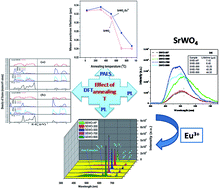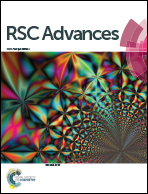Luminescence of undoped and Eu3+ doped nanocrystalline SrWO4 scheelite: time resolved fluorescence complimented by DFT and positron annihilation spectroscopic studies†
Abstract
SrWO4 (SWO) and Eu3+ doped SrWO4 (SEWO) scheelite samples were synthesized using a polyol method. Crystallite sizes of the as prepared samples annealed at 300 and 500 °C are in a similar range (<20 nm) whereas those annealed at 700 and 900 °C are about ∼40–50 nm and 80–100 nm, respectively. Photoluminescence (PL) spectra of SWO samples show a broad peak corresponding to the oxygen to tungsten charge transfer transition. Along with the enhancement in emission intensity in the samples annealed at 700 and 900 °C, there is a blue shift in peak maxima. Our first principles quantum mechanical calculations showed that the break in symmetry of the unit cell of SrWO4 creates inherent defects in the lattice which are responsible for the reduction of the electronic band gap in the SrWO4 sample with decrease in size. On europium doping; energy transfer from the O2− → W6+ charge transfer band to Eu3+ takes place and the reason behind this is explained using density functional theory (DFT) calculations. Based on time resolved PL measurements, it is suggested that Eu3+ ions occupy two sites in SWO; a regular symmetric Sr2+ site and an asymmetric site (closer to charge compensating defects). With increase in annealing temperature, emission intensity as well as asymmetry around europium increased. The changes in asymmetry around europium and defect densities as determined from positron annihilation lifetime spectroscopy (PALS) suggest that though the overall vacancy concentration is reduced with an increase in annealing temperature, it is likely that vacancies closer to europium are slowly annealed out than the others.


 Please wait while we load your content...
Please wait while we load your content...